(Cover image: Picture of fall leaves)
Dear readers,
A tumble here, a near-miss there; falls aren’t just a minor inconvenience for seniors. They can lead to serious injuries and loss of independence. But here’s the good news: most falls are preventable! The first step? Knowing what causes them. Let’s break down 10 common risk factors for falls in seniors and, more importantly, how to keep yourself (or your loved ones) safely on two feet. Here they are as follows:
10 Common Risk Factors for Falls in Seniors
1. Poor Balance – The Wobble Factor
Ever feel like you’re walking on a tightrope instead of your living room floor? As we age, our balance isn’t what it used to be. Weak core muscles, neurological issues, or even just inactivity can throw us off.
Prevention Tip: Try balance exercises like standing on one foot or tai chi. A sturdy cane or walker can also provide extra support if needed.
2. Weak Muscles – The “I’ll Get That Later” Syndrome
Getting up from a chair shouldn’t feel like an Olympic sport, but for some seniors, it does. Muscle weakness, particularly in the legs, can make everyday movements challenging and unstable.
Prevention Tip: Strength training isn’t just for bodybuilders! Simple exercises like squats, leg lifts, or even resistance bands can keep your muscles strong.
3. Vision Problems – The Surprise Step
Your eyes are your first line of defense against falls, but cataracts, glaucoma, or poor depth perception can turn a simple step into a hidden hazard.
Prevention Tip: Keep up with regular eye exams and update your glasses prescription. Also, ensure good lighting throughout your home, especially in stairways and hallways.
4. Medications – The Dizzy Spells
Some medications, especially those for blood pressure, sleep, or depression, can make you feel dizzy or lightheaded. Mixing multiple prescriptions? That increases the risk even more.
Prevention Tip: Have your doctor review your medications regularly. If you notice dizziness, ask if adjustments can be made.
5. Home Hazards – The Sneaky Tripping Traps
That loose rug, the coffee table that’s a little too close, or the shoes left in the hallway. They’re all waiting to trip you up!
Prevention Tip: Keep pathways clear, secure rugs with non-slip pads, and consider installing grab bars in high-risk areas like bathrooms.
6. Foot Problems – The Unhappy Feet
Bunions, arthritis, or simply wearing the wrong shoes can make walking feel like navigating a minefield.
Prevention Tip: Invest in sturdy, non-slip footwear with good arch support. And if foot pain is an issue, see a podiatrist for proper care.
7. Chronic Conditions – The Unexpected Side Effects
Diabetes, Parkinson’s, arthritis, and even heart disease can impact balance, coordination, and strength, making falls more likely.
Prevention Tip: Manage chronic conditions with regular check-ups and follow your doctor’s advice on physical activity and treatment.
8. Low Blood Pressure – The Sudden Drop
Ever stand up too fast and feel dizzy? That’s orthostatic hypotension which is your blood pressure dropping suddenly. It’s a major cause of falls in seniors.
Prevention Tip: Stand up slowly, stay hydrated, and talk to your doctor if this happens often. Compression socks can also help with circulation.
9. Dehydration & Poor Nutrition – The Energy Drain
If your body isn’t fueled properly, you’re more likely to feel weak, dizzy, and unsteady. And let’s be honest, skipping meals or forgetting to drink enough water happens more often than we admit.
Prevention Tip: Eat a balanced diet rich in protein, healthy fats, and vitamins. Keep a water bottle nearby to remind yourself to drink throughout the day.
10. Fear of Falling – The Irony of It All
Here’s the twist – being afraid of falling can actually make you more likely to fall! When seniors avoid movement out of fear, they lose muscle strength and confidence, which increases the risk.
Prevention Tip: Stay active, practice balance exercises, and use assistive devices if needed. Confidence is key to preventing falls!
Concluding Thoughts
Falls are common, but they don’t have to be inevitable. By tackling these 10 common risk factors for falls in seniors, you (or your loved ones) can reduce the chances of a nasty fall.
A few simple adjustments: stronger muscles, better lighting, and safer shoes can make a world of difference. Stay Upright and Stay Independent!
Now, go forth and stay steady! And if you’ve got any fall-prevention tricks up your sleeve, share them in the comments – I’d love to hear them!
Thank you for reading.
Any suggestions or ideas leave them below.
Blessings always,
Maxine
Quote of the day:
“Prevention is better than cure.” – Desiderius Erasmus
Shop Tips:
Book and Textbook on Amazon
Enjoy!!





